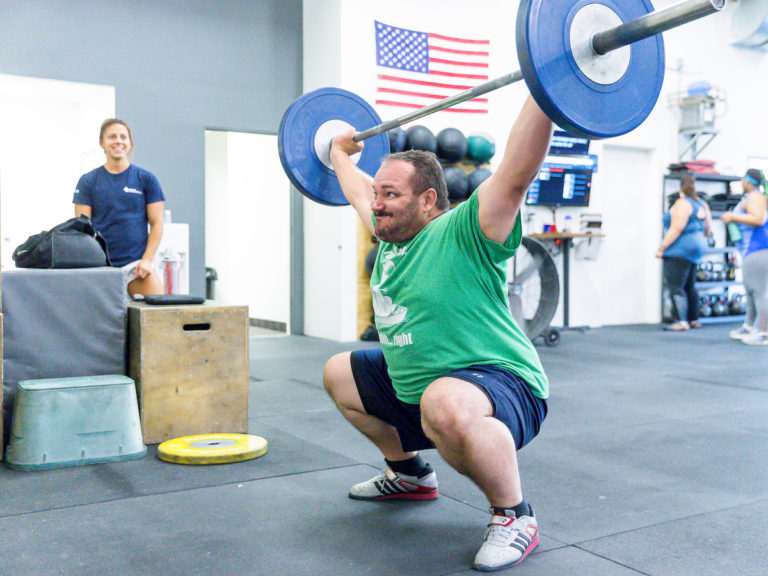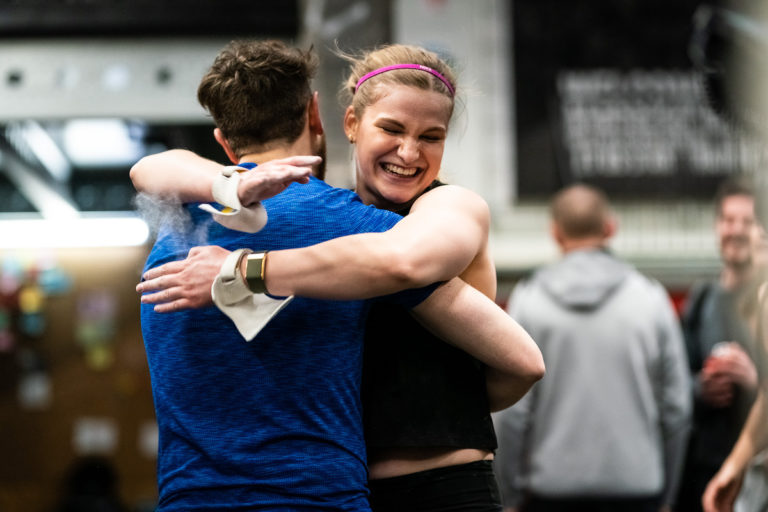In CrossFit, our goal is to utilize constantly varied, functional movement executed at high intensity to develop fitness — or work capacity across broad time and modal domains.
Generally speaking, as CrossFitters, coaches, and affiliate owners, we’re seeking tools and methods that will help us develop this capacity while balancing safety, efficacy, and efficiency to maximize results for our athletes in a measurable, observable, and repeatable way. To this end, competition is one of the most powerful tools at our disposal.
Competition Bleeds Into Group Class Efforts
CrossFit coaches know that “intensity is the independent variable most commonly associated with maximizing the rate of return on favorable adaptation to exercise.” This intensity is prescribed relative to the athlete’s physical and psychological tolerances, meaning high intensity can look dramatically different for a grandmother new to training relative to a 24-year-old Games athlete in their prime. But independent of the absolute power generated, each athlete should strive to push just outside their comfort zone as this is where the results lie.
 The trouble is, intensity hurts. It’s hard. It can even be scary. Plus, a coach telling an athlete to approach the limits of their physical and psychological tolerances is likely to be met with a blank stare. Within competition, however, it’s common for an athlete to discover they can jump back on the bar sooner, finish a set without taking a break, or speed up in the final lap. Each time this happens, it unlocks a new level of training, which equates to better results over time. Competition helps athletes discover another gear, essentially providing another opportunity for the athlete to improve their work capacity.
The trouble is, intensity hurts. It’s hard. It can even be scary. Plus, a coach telling an athlete to approach the limits of their physical and psychological tolerances is likely to be met with a blank stare. Within competition, however, it’s common for an athlete to discover they can jump back on the bar sooner, finish a set without taking a break, or speed up in the final lap. Each time this happens, it unlocks a new level of training, which equates to better results over time. Competition helps athletes discover another gear, essentially providing another opportunity for the athlete to improve their work capacity.
Trying to get the top score on the whiteboards in our affiliates, or amongst a subset of athletes we consider our peers, is an initial expression of competition. Beyond this, coaches should guide athletes to competitions and events that are programmed with an appropriate level of skill, strength, and volume (both in number of workouts as well as number of reps) relative to the athlete’s fitness level. Competitions your athletes pursue should include movements and rep schemes that will be an appropriate, rather than overwhelming, challenge. Event organizers should also be cognizant of the fitness and ability levels of their participants (e.g., defining variations in programming for a 55+ division versus a 17-34 division).
Prepare for the Unknown and Unknowable: The Hopper
In CrossFit, we use constantly varied, functional movement to expand our capacity and prepare to face any challenge life may throw at us. Any limitation in functional capacity — whether a particular time domain, rep volume, level of external load, or specific movement — represents a gap in which the ability to perform work, or move large loads long distances quickly, declines, or even decreases to zero. These functional gaps often represent the areas where targeted effort will result in the greatest overall gain or the highest increase in work capacity.
Officially signing up for competitions like the Open, licensed CrossFit events or local throwdowns — and especially dreaming of competing in the CrossFit Games — up the ante on the possibility that the elements an athlete most nervously anticipates may come out of the Hopper — whether that be handstand push-ups, a 10-k run, or a bodyweight snatch. This anticipation can be remarkably helpful in motivating an athlete to consistently target a handful of relative weaknesses.
Targeting weaknesses is generally useful in helping the athlete perform better in the eventual competition, and it also helps them perform better in every aspect of their life that was previously limited by that weakness — and therein lies the magic. The motivation the competition provides makes them fitter whether the thing they prepared for appears in the programming or not.
Emotionally Invested
Athletes being willing to admit they aren’t able to do something, or aren’t very good at something, is a necessary foundation to begin developing capacity in whatever that thing is. For many people, CrossFit classes and competitions become opportunities for athletes to be vulnerable, share their results, and experience the community that builds around both positive and negative outcomes. Regardless of their scores each day, athletes are met with celebration, encouragement, and accountability, which creates space to try new skills. For this reason, competition is a fantastic opportunity to enhance the community experience within the affiliate. For the athlete, it’s an opportunity to give their best effort in front of their friends, and then lie in a sweaty heap on the floor while people rush over to give them a high five, acknowledge their effort, and congratulate them on their results.
For many people, CrossFit represents the first time they put themselves into a physically competitive situation, the first time they intentionally risked public failure, the first time they realized how cool it is to have a room full of people enthusiastically cheering for their performance, accepting them even when they can’t do a pull-up or they struggle to overhead squat a PVC pipe. For most athletes, whether it’s their first competitive experience or one that numbers in the thousands, the joy of those moments never fades.
As fans, we get emotionally involved, willing our favorite athlete to hang on to the bar, suffering alongside them as the sweat pours down their face, and ultimately sharing in the emotion of their result whether it be elation, defeat, or anything in between. In class, athletes get to enjoy overcoming the challenge the Workout of the Day represents side-by-side. In competition, they get excited about others’ goals, whether that be higher placement, advancing to another stage of competition, getting a “first,” or even just finishing the workout.
From the perspective of the affiliate, competition becomes an opportunity for members to observe each other, recognize the progress athletes from their affiliate have made, and admire the displays of effort paired with vulnerability. Competitions essentially enhance the expression of community — between competitors and their coaches, within affiliates, and even among judges and event organizers.
Is Competition for Everyone?
It is worth noting that while anyone can benefit from competition, not everyone should participate in any competition at any moment in time. Athletes who are newer to CrossFit, learning the foundational movements, or who haven’t been training consistently are not likely to benefit from increasing intensity prior to establishing consistency and sound mechanics.

In addition, coaches should be aware that some athletes find themselves psychologically overwhelmed by the pressure of an official competition. In this case, the potential for failure, the fear of the challenge, or any other number of concerns may serve to discourage the athlete, rather than motivate them. For these athletes, it’s likely best to accept that a formal competition is beyond the limits of their psychological tolerance in the short term. Instead, a coach can look for tiny moments in which to infuse elements of competition within class: challenging the athlete to complete 3 more reps before setting down the bar, acknowledging that they completed their final round of the workout a little faster than a classmate, or alerting them that a pull-up challenge is coming up in a few weeks. This approach is likely to help the athlete slowly gain appreciation for the benefits of competition over time, essentially reducing the risk that the athlete will get scared off before they have a chance to learn to enjoy competing.
When it comes to CrossFit, competition enhances the CrossFit experience for athletes and the affiliates they represent, and opens new avenues for growth after the competition. Whether your athletes are chomping at the bit to get involved in the competitive sphere or they’re just starting out, there are always ways to implement these three aspects of competition — providing additional exposure to intensity, preparing for the unknown and unknowable, and participating in a supportive community — in your coaching.
About the Author
Sarah Hopping Estrella, M.S., CF-L3, found CrossFit shortly after missing qualifying for the U.S. Olympic Team by 90cm in the Hammer Throw. CrossFit was so effective in promoting simultaneous increases in strength, gymnastic skills, and metabolic capacity that she left a career in investment banking to open a CrossFit affiliate, serve on the CrossFit Level 1 Seminar Staff, and compete in both CrossFit and Olympic Weightlifting. She is currently the Director of Educational Content at CrossFit.